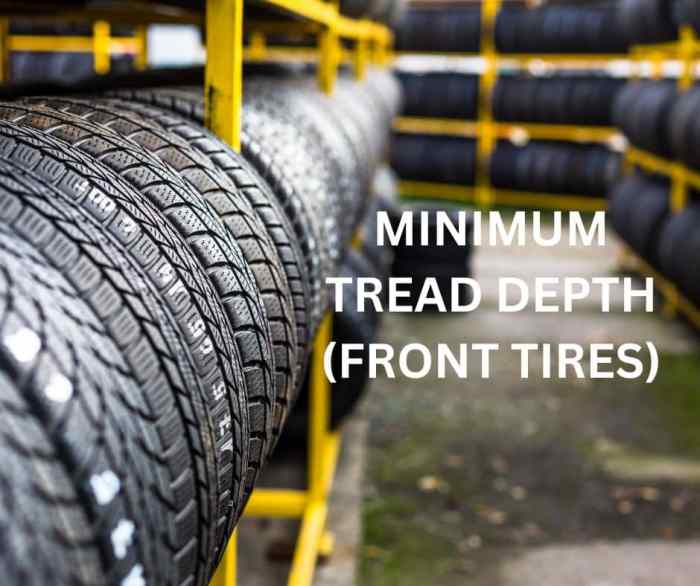The minimum tread depth for front tires is a crucial aspect of vehicle safety and performance, demanding attention and understanding from every responsible driver. This comprehensive guide delves into the intricate details of tread depth regulations, measurement techniques, and the consequences of insufficient tread depth, empowering readers with the knowledge necessary to ensure optimal tire performance and safety on the road.
Beyond legal compliance, maintaining adequate tread depth is paramount for maintaining traction, handling, and braking capabilities, reducing the risk of accidents and enhancing overall driving experience. By understanding the factors affecting tread depth and implementing proper tire maintenance practices, drivers can extend tire life, improve fuel efficiency, and contribute to environmental sustainability.
Minimum Tread Depth Regulations: Minimum Tread Depth For Front Tires

To ensure optimal tire performance and safety, various regions have established legal requirements for minimum tread depth for front tires.
Examples of Regulations
- United States: 2/32 inches (1.6 millimeters)
- European Union: 1.6 millimeters
- United Kingdom: 1.6 millimeters
- Canada: 2/32 inches (1.6 millimeters)
Non-compliance with these regulations can result in fines, vehicle inspections, and even impoundment.
Tread Depth Measurement Techniques
Accurate tread depth measurement is crucial for determining tire safety and compliance with regulations.
Tread Depth Gauges
Tread depth gauges are specialized tools designed to measure the remaining tread on tires. They are inserted into the tread grooves and provide a precise measurement in millimeters or inches.
To use a tread depth gauge:
- Insert the gauge into the deepest groove on the tire.
- Press down firmly until the gauge contacts the base of the groove.
- Read the measurement on the gauge.
Penny Test
The penny test is a simple method for estimating tread depth. Insert a penny into the tread groove with Lincoln’s head facing down. If the top of Lincoln’s head is visible, the tread depth is less than 2/32 inches (1.6 millimeters) and the tire should be replaced.
Factors Affecting Tread Depth

Several factors can influence the rate of tread wear and affect tread depth.
Driving Habits
- Aggressive driving, such as hard acceleration, braking, and cornering, can accelerate tread wear.
- Driving on rough or uneven roads can also increase wear.
Road Conditions
- Wet or icy roads can reduce traction and increase tread wear.
- Driving on gravel or dirt roads can also contribute to tread loss.
Tire Type
- Performance tires, designed for high-speed handling, typically have shallower tread depths than all-season tires.
- All-terrain tires, intended for off-road use, often have deeper tread patterns for improved traction.
Consequences of Insufficient Tread Depth

Driving on tires with insufficient tread depth poses significant safety risks.
Reduced Traction, Minimum tread depth for front tires
Tires with worn tread have reduced grip on the road surface, leading to decreased traction and increased risk of skidding.
Impaired Handling
Worn tires can compromise vehicle handling, making it more difficult to control and maneuver, especially in wet or icy conditions.
Extended Braking Distance
Insufficient tread depth increases the braking distance, reducing the driver’s ability to stop the vehicle in a timely manner.
Accidents
Insufficient tread depth has been linked to numerous accidents, including those involving loss of control, skidding, and hydroplaning.
Questions and Answers
What is the legal minimum tread depth for front tires in most countries?
The legal minimum tread depth for front tires varies by country or region. In the United States, for example, the minimum tread depth is 2/32 of an inch (1.6 millimeters).
How often should I check my tire tread depth?
It is recommended to check your tire tread depth at least once a month, especially before long trips or when driving in hazardous conditions.
What are the consequences of driving on tires with insufficient tread depth?
Driving on tires with insufficient tread depth can lead to reduced traction, poor handling, increased braking distances, and hydroplaning, all of which can increase the risk of accidents.